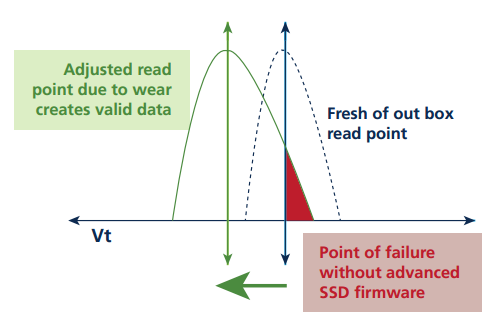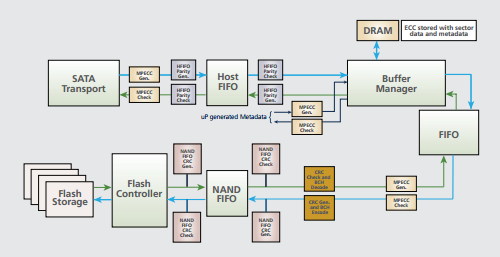Micron P400m SSD Review: High Endurance MLC Is Here To Stay
Endurance. Reliability. Data protection. They're all important factors when it comes time to evaluate high-end storage technology. Micron's P400m, the company's latest enterprise-class SSD, is positioned to not only address those needs, but exceed them.
Extended Performance And Enhanced Reliability Technology (XPERT)
Any time we talk about a product built using components and technologies from one vendor, we have to consider the advantages of vertical integration. SSD vendors that manufacture the NAND in their drives have an inherent advantage over the companies that buy their memory. This can show up in pricing, in performance, or in reliability. In each case, though, it's only possible to extract those benefits through comprehensive testing.
With its P400m, Micron is hoping to differentiate itself from the competition through a set of enhancements designed to extend the SSD's life and guarantee the reliability of stored data. Some of the comprising features have shown up previously, while others are completely new. Micron calls this collection of storage architecture features XPERT, for eXtended Performance and Enhanced Reliability Technology.
The first feature in XPERT, dubbed Adaptive Read Management/Optimized Read (ARM/OR), is described by Micron as: a dual-faceted data management technique with both proactive and inline protection. In proactive mode, ARM/OR ensures that data stored on the SSD is immediately available by sampling the stored data and dynamically tuning the NAND device in the background. This tuning, based on Micron-specified thresholds, is completely transparent with no effect on drive or system performance. ARM/OR inline mode provides additional protection by making fast and precise foreground tuning when the host reads data from the XPERT-enabled SSD.
Memory cells change over time, based on wear. If a controller continues to access them the same way during an SSD's life, the point at which you'll start experiencing bit errors will be sooner than if read parameters are adjusted dynamically. ARM/OR runs in the background, sampling the memory and tuning it based on thresholds defined by Micron. This management helps extend the useful life of the NAND, simultaneously allowing the company to use less expensive memory and lowering the total cost of ownership.
The next feature in XPERT is DataSAFE, which Micron says: protects user data as it moves from the host to the SSD interface, through the data path inside the SSD, into the storage media, and back. In addition, DataSAFE embeds the host logical block address (LBA) with the host data before storing both in the drive. Storing this additional information (also known as metadata) helps to ensure that XPERT-enabled SSDs return the exact data requested. In addition, DataSAFE includes error-correcting code, which protects data by adding ECC coverage to the information as it enters the DRAM on the SSD. This also ensures that data is committed to NAND without modification.
The final feature is dubbed RAIN, or Redundant Array of Independent NAND. We last saw this feature in Micron RealSSD P320h Review: A PCIe Drive Capable Of 3.2 GB/s. RAIN is most easily characterized as a RAID 5 implementation across flash channels. In the P400m, the implementation is 15+1, meaning you get 15 elements of user data and one element of parity data.
Looking at the individual components of XPERT, you can see how they all fit together. Micron is using a layered approach to data management. While each feature focuses on separate functional blocks and data paths, they all emphasize data integrity and protection.
Get Tom's Hardware's best news and in-depth reviews, straight to your inbox.
Current page: Extended Performance And Enhanced Reliability Technology (XPERT)
Prev Page Inside Micron's P400m SSD Next Page Test Setup, Benchmarks, And Methodology-
Nintendo Maniac 64 に?Reply
Seriously though, I wonder why Tom's doesn't run one of their basic "real-world" tests used on consumer SSDs (such as Tom's 7zip test) on one of these professional SSDs just so that we can get an idea how they compare to the consumer-level stuff.
In particular, Tom's always says that comparing one SSD to another is nearly moot point when you consider the magnitude of improvement an SSD has over a traditional HDD; it would be nice to know if these pro-level SSDs are of a similar magnitude of improvement over consumer SSDs or whether the difference is actually less. -
blazorthon Nintendo Maniac 64に?Seriously though, I wonder why Tom's doesn't run one of their basic "real-world" tests used on consumer SSDs (such as Tom's 7zip test) on one of these professional SSDs just so that we can get an idea how they compare to the consumer-level stuff.In particular, Tom's always says that comparing one SSD to another is nearly moot point when you consider the magnitude of improvement an SSD has over a traditional HDD; it would be nice to know if these pro-level SSDs are of a similar magnitude of improvement over consumer SSDs or whether the difference is actually less.Reply
The difference is much, much less in terms of performance difference. Tom's has told us this time and time again. -
mayankleoboy1 Nintendo Maniac 64に?Seriously though, I wonder why Tom's doesn't run one of their basic "real-world" tests used on consumer SSDs (such as Tom's 7zip test) on one of these professional SSDs just so that we can get an idea how they compare to the consumer-level stuff.In particular, Tom's always says that comparing one SSD to another is nearly moot point when you consider the magnitude of improvement an SSD has over a traditional HDD; it would be nice to know if these pro-level SSDs are of a similar magnitude of improvement over consumer SSDs or whether the difference is actually less.Reply
In desktop loads, very very less difference.
In server loads, huge difference. Plus, these server SSD's wil maintain high speeds even after large amounts of data is continuously being written. -
mayankleoboy1 theoretical question : how much life would 100% provisioning give ? So you ship a 512GB MLC drive, but the usable is only 256GB. The rest 256GB is for getting better wrtite endurance.Reply
How would this compare to a true SLC SSD ? -
blazorthon mayankleoboy1theoretical question : how much life would 100% provisioning give ? So you ship a 512GB MLC drive, but the usable is only 256GB. The rest 256GB is for getting better wrtite endurance. How would this compare to a true SLC SSD ?Reply
It'd probably still be inferior overall and not even be cheaper at that point. Over-provisioning is only good for mitigating MLC's disadvantages over SLC AFAIK, not replacing SLC. -
blazorthon mayankleoboy1In desktop loads, very very less difference.In server loads, huge difference. Plus, these server SSD's wil maintain high speeds even after large amounts of data is continuously being written.Reply
Even in server workloads, there are many desktop drives where the performance difference is still not great. For example, Vector is right up there at the tops of the charts with Samsung 840 Pro in performance and many cheaper alternatives are often not far behind in performance. Endurance is another matter, but that wasn't the question. If you want a seriously significant performance difference like with HDDs versus cheap consumer SSDs, you have to consider SSD RAID and/or extreme PCIe storage.
Also, many consumer drives have no trouble keeping performance over time with lots of data written. That's also not an enterprise-only feature. -
drewriley mayankleoboy1theoretical question : how much life would 100% provisioning give ? So you ship a 512GB MLC drive, but the usable is only 256GB. The rest 256GB is for getting better wrtite endurance. How would this compare to a true SLC SSD ?Reply
Some back of the napkin calculations - If you have a consumer 512GB MLC SSD with no over-provisioning, and the MLC was high grade consumer, you could expect 5K P/E cycles. In order to mimic the P400m, which is 35K P/E cycles, the usable space would be ~75GB. By dong that, you would be paying roughly $7/GB for usable storage(assuming you paid $512 for your consumer drive). For SLC, you are looking at 17GB of usable space and $30/GB.
No matter how you look at it, consumer grade MLC will never get close to eMLC and SLC in terms of write endurance, unless the price goes down by orders of magnitude compared to eMLC and SLC. -
drewriley blazorthonEven in server workloads, there are many desktop drives where the performance difference is still not great. For example, Vector is right up there at the tops of the charts with Samsung 840 Pro in performance and many cheaper alternatives are often not far behind in performance. Endurance is another matter, but that wasn't the question. If you want a seriously significant performance difference like with HDDs versus cheap consumer SSDs, you have to consider SSD RAID and/or extreme PCIe storage.Also, many consumer drives have no trouble keeping performance over time with lots of data written. That's also not an enterprise-only feature.Reply
You are correct. Many drives, such as the 840 PRO, would perform great on the enterprise performance tests. There are also a lot of consumer drives that would have problems over time if they aren't allowed to TRIM every so often. We limit the scope of our testing because the main use cases for these drives are enterprise. Will some companies use them in workstations, absolutely. The same can be said for high-end RAID cards too. Nearly every consumer drive would perform very poorly when you take into account write endurance and other enterprise features. -
themdg This technology is moving so fast...hard to keep up. I feel like these articles could use that line from Tommy Boy and get the same point across (to me, at least).Reply
"These hard drives are really cool...you're not even gonna believe it..."

